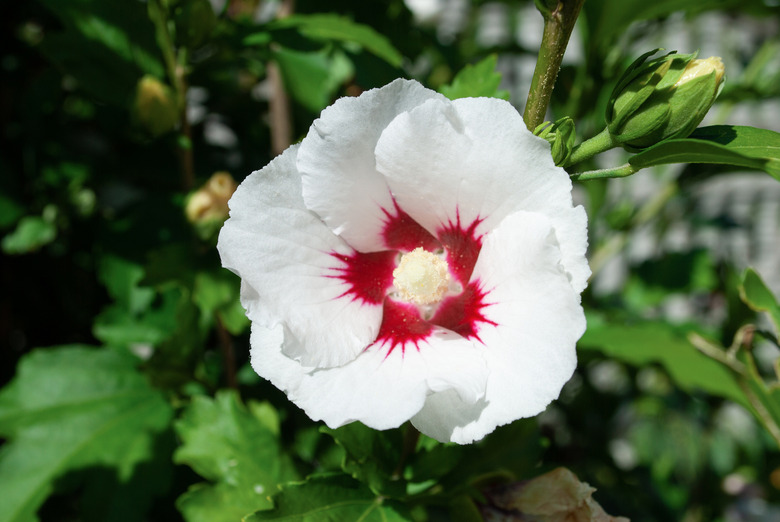How To Transplant Rose Of Sharon
We may receive a commission on purchases made from links.
The upright growth and tropical-like flowers of the rose of Sharon (Hibiscus syriacus), also known as shrub althea, make it an attractive perennial addition to both formal and informal gardens in U.S. Department of Agriculture plant hardiness zones 5 through 9. If your established shrub or volunteer seedling is growing in the wrong place, you can best transplant rose of Sharon in fall or early spring.
About Rose of Sharon
About Rose of Sharon
A native of Asia ranging from China to India, this large shrub grows from 8 to 12 feet tall and 6 to 10 feet wide. It prefers a sunny location, though it will grow in part shade. Although it tolerates occasional wet soil, it grows best on well-draining sites.
Rose of Sharon can be allowed to grow into its natural multistemmed shrub form or trimmed into a tree form with one or more trunks. Deadhead the fading flowers before seeds set so it doesn't spread volunteers in the garden and nearby meadows.
While the species plant tends toward pink flowers and readily sets seeds, Hibiscus syriacus 'Bluebird' features single lavender-blue flowers, and Hibiscus syriacus 'Blue Chiffon' has double lavender flowers. Among the newer, sterile cultivars are white-flowering Hibiscus syriacus 'Diana,' white-flowering with a maroon throat Hibiscus syriacus 'Helene' and pink-flowering Hibiscus syriacus 'Aphrodite.' If there's room for just one, consider Hibiscus syriacus 'Tricolor,' which produces double pink, red and purple flowers on the same plant.
Prune the Roots
Prune the Roots
Begin in early spring, if possible, by pruning the roots while the shrub is dormant. First, water thoroughly the day before you plan to trim the roots. Take time to sanitize your shovel and cutting tools by cleaning the blades and then wiping them with rubbing alcohol.
Put on safety goggles, long sleeves, long pants, gloves and closed-toe shoes before you begin. Wrap the shrub with twine or burlap to pull the branches close to the trunk and out of your way. Measure a circle around the shrub halfway between the trunk and drip line or 12 inches in diameter for every inch of the trunk's diameter.
Dig a 12- to 18-inch-deep trench around the shrub to cut the tiny feeder roots. Use pruners or loppers to cut larger roots. Refill the trench with the excavated soil, untie the branches and water thoroughly. Over the summer, more feeder roots will grow to replace the cut roots, mostly inside of the trench.
Transplant Rose of Sharon
Transplant Rose of Sharon
In fall after the shrub drops its leaves and goes dormant, repeat the watering and tying up of the branches. Dig the new hole two to three times as wide as the root ball. Fill the hole with water and let it soak into the soil while you dig up the rose of Sharon.
Dig a new trench approximately 6 inches larger than the previous trench around the shrub. Cut the roots as needed and dig 12 to 18 inches down before angling the trench inward. Dig under the shrub until you've freed the root ball from the soil. Tip the shrub onto a tarp and then pull it up onto a wheelbarrow or dolly to move it to the new planting hole.
Keep the roots moist with wet burlap or newspapers while transporting the shrub; don't let them dry out. Check the depth of the new hole and dig a little deeper if necessary to accommodate the root ball. Tip the shrub into the hole, straighten it and then backfill with the excavated soil. Tamp gently and add more soil as needed so the rose of Sharon is at the same depth as it was in its previous home.
Care After Transplanting
Care After Transplanting
Water thoroughly to settle the fill and add more soil as needed. Keep the soil evenly moist but not waterlogged. Add a 2- to 4-inch layer of mulch around the rose of Sharon, pulling it back 4 to 6 inches from the trunk.
In spring as the shrub begins to develop leaf buds, evaluate the branches and trim as needed to remove dead or broken limbs. Also remove crossing or crowded branches to increase air circulation through the shrub. Monitor through the first season and remove suckers from the bottom part of the trunk and root suckers as they appear. After the rose of Sharon is established in its new location, you can prune to a tree form when it goes dormant in fall or let it continue growing as a large shrub.
Fertilize in spring with a slow-release, balanced fertilizer and fertilize lightly midseason with a 0-10-10 fertilizer. Water thoroughly after fertilizing. A few shovelfuls of compost tossed over the root ball in spring and again at midseason also adds nutrients to continue nourishing the shrub.
